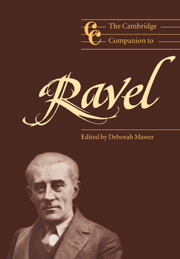Book contents
- Frontmatter
- Introduction
- Part I Culture and aesthetic
- Part II Musical explorations
- 4 Ravel and the piano
- 5 Harmony in the chamber music
- 6 Ravel and the orchestra
- 7 Ballet and the apotheosis of the dance
- 8 Vocal music and the lures of exoticism and irony
- 9 Ravel's operatic spectacles: L'Heure and L'Enfant
- Part III Performance and reception
- Appendix: Early reception of Ravel's music (1899–1939)
- Notes
- Select bibliography
- Index of names and works
5 - Harmony in the chamber music
from Part II - Musical explorations
Published online by Cambridge University Press: 28 September 2011
- Frontmatter
- Introduction
- Part I Culture and aesthetic
- Part II Musical explorations
- 4 Ravel and the piano
- 5 Harmony in the chamber music
- 6 Ravel and the orchestra
- 7 Ballet and the apotheosis of the dance
- 8 Vocal music and the lures of exoticism and irony
- 9 Ravel's operatic spectacles: L'Heure and L'Enfant
- Part III Performance and reception
- Appendix: Early reception of Ravel's music (1899–1939)
- Notes
- Select bibliography
- Index of names and works
Summary
Ravel's popular, if somewhat misleading, identification as an ‘impressionist’ composer depends on three categories of his achievement: orchestral music, piano music and vocal music, including operas as well as songs. His chamber music is of another stripe, revealing another all-important side of his musical persona: it is classically based absolute music, without ties to texts, literary references or descriptive titles. In this regard as in so many others, he is like Debussy, but, while Debussy's chamber music frames his career at beginning and end, Ravel's chamber music follows his career throughout, providing significant landmarks at different stages.
Ravel's chamber music, like his piano music, inclines to formal variety, yet always as concisely and precisely as the classical masters whom he so much admired. One never finds the formal adventurousness and only seldom the textural experimentation that characterise the musical ‘impressionism’ of his most radical piano works like Gaspard de la nuit. Yet the essential wholeness of Ravel's personal style is never in doubt; the highly individual melodic idiom and the integrity of his harmonic language are unified between the chamber music and all the other works, in continuous evolution from the beginning of his maturity to the end of his career.
- Type
- Chapter
- Information
- The Cambridge Companion to Ravel , pp. 97 - 117Publisher: Cambridge University PressPrint publication year: 2000
- 2
- Cited by

